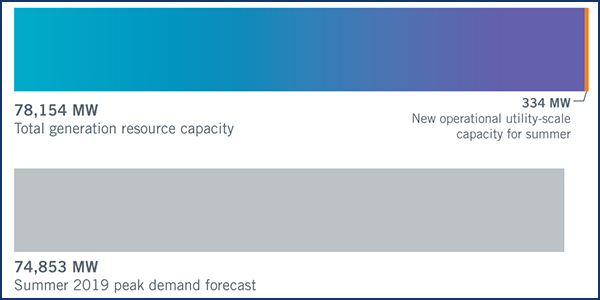By Tom Kleckner
ERCOT is forecasting record peak demand with increased potential emergency alerts this summer, given its historically low planning reserve margin of 7.4%.
The grid operator said Tuesday it expects a summer peak of 74.9 GW, which would break the mark of 73.3 GW set just last summer. ERCOT has 78.2 GW of capacity on hand to meet that demand, according to its preliminary summer seasonal assessment of resource adequacy (SARA).
David Bellman, head of power for Houston-based Skylar Capital Management, told RTO Insider the “surprising thing to note” is this year’s projected peak is almost 3% higher than last year’s predicted high of 72.8 GW, as well as being 1.6 GW higher than 2018’s actual peak.
Bellman said the forward markets lost about $2/MWh Tuesday and were trading at $138/MWh.
“The increase in peak demand and drop in resource adequacy means we expect emergency alerts to be issued this summer,” Resource Adequacy Manager Pete Warnken said during a media call.
Declaring an energy alert during scarcity situations would free up the ISO to tap into a variety of additional resources to meet demand. Those resources include demand response products, resources normally set aside to provide operating reserves, additional generation or imports from neighboring RTOs, and calls for voluntary conservation measures.
Dan Woodfin, ERCOT’s director of system operations, said the grid operator has 900 MW of emergency response service available and another 1,300-1,800 MW of capacity from load-management programs.
The grid operator’s reserve margin dropped from 8.1% to 7.4% with the December retirement of the Gibbons Creek coal plant. Warnken said 500 MW of summer capacity, much of it from wind and solar projects, has been delayed until late spring and early summer.
The final summer SARA report will be released in May and will reflect the expected summer weather conditions.
ERCOT also released its final SARA for the spring months (March-May), saying it has sufficient capacity (81.3 GW) to meet a forecasted spring peak of 61.6 GW. The system has added 577 MW of planned gas, wind and solar resources for the spring, with another 50 MW of wind and solar capacity expected to be available for the season’s start.






